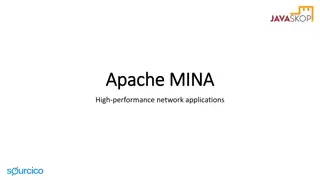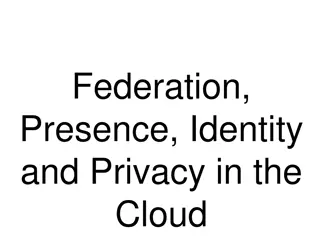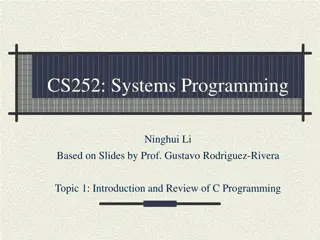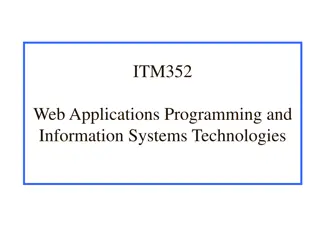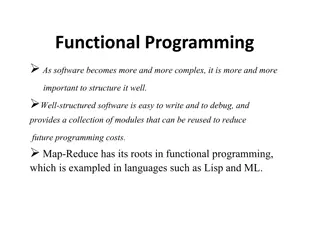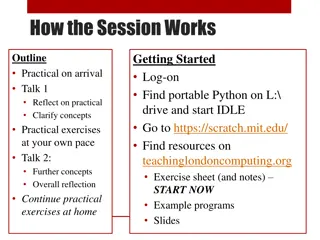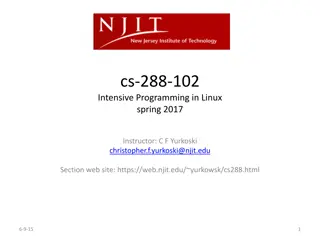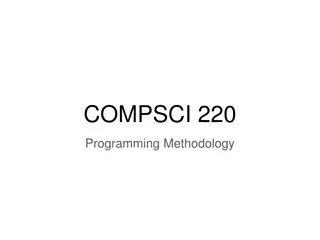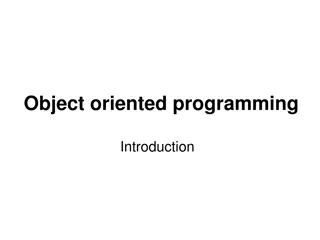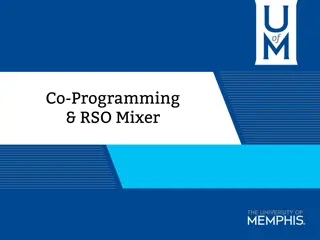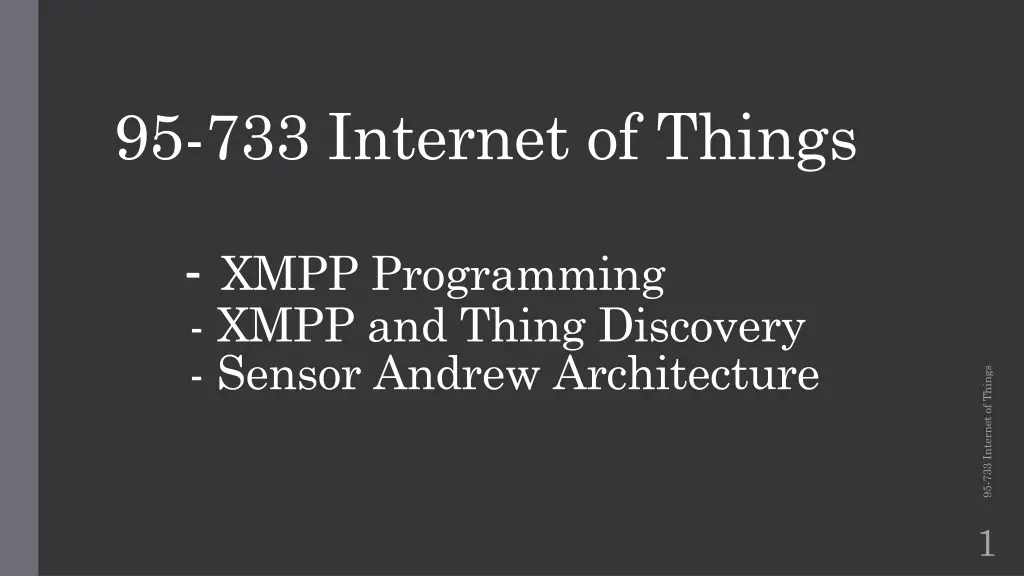
Understanding XMPP Programming for Internet of Things Applications
Explore the world of XMPP programming in the context of Internet of Things, including thing discovery, sensor architecture, and message exchange protocols. Learn about XMPP stanzas and examples of server-client interactions through XML messaging.
Download Presentation

Please find below an Image/Link to download the presentation.
The content on the website is provided AS IS for your information and personal use only. It may not be sold, licensed, or shared on other websites without obtaining consent from the author. If you encounter any issues during the download, it is possible that the publisher has removed the file from their server.
You are allowed to download the files provided on this website for personal or commercial use, subject to the condition that they are used lawfully. All files are the property of their respective owners.
The content on the website is provided AS IS for your information and personal use only. It may not be sold, licensed, or shared on other websites without obtaining consent from the author.
E N D
Presentation Transcript
95-733 Internet of Things - XMPP Programming - XMPP and Thing Discovery - Sensor Andrew Architecture 95-733 Internet of Things 1
XMPP Programming Extensible Messaging and Presence Protocol 95-733 Internet of Things 2
Recall the example (from IBM) Note: the XML is being transferred in pieces. The TCP connection only closes at the end. Note: there are two XML documents involved. 95-733 Internet of Things Would this work over websockets? Sure. It involves a bidirectional conversation. 3
Within streams are XML stanzas The example above uses the <message> stanza. Stanzas are well formed and complete XML messages Three Stanza types enclosed in a stream tag: <Presence> user status shared with all on the XMPP roster, I am online I am interested in knowing about your presence , ... <IQ> information query, request and change settings, discovery of services 95-733 Internet of Things <Message> used for person to person chat These stanzas have many many options. 4
XMPP Example Messages (1) The server pings the client with an information (IQ) stanza <iq from='capulet.lit' to='juliet@capulet.lit/balcony' id='s2c1' type='get'> <ping xmlns='urn:xmpp:ping'/> </iq> The client responds: <iq from='juliet@capulet.lit/balcony' to='capulet.lit' id='s2c1' type='result'/> 95-733 Internet of Things A server pings another server: <iq from='capulet.lit' to='montague.lit' id='s2s1' type='get'> <ping xmlns='urn:xmpp:ping'/> </iq> 5
XMPP Example Messages (2) A client pings another client (an end-to-end ping): <iq from='romeo@montague.lit/home' to='juliet@capulet.lit/chamber' type='get' id='e2e1'> <ping xmlns='urn:xmpp:ping'/> 95-733 Internet of Things </iq> 6
XMPP XML Schema for a ping (1) <! XML Schema is used to describe the grammar and vocabulary of an XML language <?xml version='1.0' encoding='UTF-8'?> <xs:schema xmlns:xs='http://www.w3.org/2001/XMLSchema' 95-733 Internet of Things targetNamespace='urn:xmpp:ping' xmlns='urn:xmpp:ping' elementFormDefault='qualified'> 7
XMPP XML Schema for a ping (2) <xs:annotation> <xs:documentation> The protocol documented by this schema is defined in XEP-0199: http://www.xmpp.org/extensions/xep-0199.html </xs:documentation> </xs:annotation> 95-733 Internet of Things 8
XMPP XML Schema for a ping (3) <xs:element name='ping' type='empty'/> <xs:simpleType name='empty'> <! a type is being defined -- > <xs:restriction base='xs:string'> <! with a type of string --> <xs:enumeration value=''/> <! with no content --> </xs:restriction> </xs:simpleType> 95-733 Internet of Things </xs:schema> 9
XMPP Example Messages Presence example Multiple subscribers receive notifications whenever the publisher (typically an end user) generates an event related to network availability. Example publication <presence from='juliet@capulet.lit/balcony'> <status>Moping</status> 95-733 Internet of Things </presence> 10
XMPP Example Messages (4) Example messages sent to subscribers: <presence from='juliet@capulet.lit/balcony' to='romeo@montague.lit/mobile'> <status>Moping</status> </presence> <presence from='juliet@capulet.lit/balcony' to='nurse@capulet.lit/chamber'> <status>Moping</status> 95-733 Internet of Things </presence> <presence from='juliet@capulet.lit/balcony' to='benvolio@montague.lit/pda'> <status>Moping</status> </presence> 11
From the perspective of the application developer We do not want to work at the XML level. We need middleware to provide support. Middleware separates concerns. It hides the details associated with messaging. Details include marshalling and un-marshaling of parameters and addressing. Details include generating the correct XMPP message to send. 95-733 Internet of Things Details include reading and writing messages to the TCP layer. At the application programmer level, WE WANT NONE OF THAT! Use middleware to hide all of that! 12
Client code in Ruby From (IBM) Listing 1. Simple XMPP agent for word definitions require 'xmpp4r/client' # Create a *very* simple dictionary using a hash hash = {} hash['ruby'] = 'Greatest little object oriented scripting language' hash['xmpp4r'] = 'Simple XMPP library for ruby' hash['xmpp'] = 'Extensible Messaging and Presence Protocol' 95-733 Internet of Things # Connect to the server and authenticate jid = Jabber::JID::new('bot@default.rs/Home') cl = Jabber::Client::new(jid) cl.connect 13 cl.auth('password')
Client code in Ruby From IBM (2) # Indicate our presence to the server cl.send Jabber::Presence::new # Send a salutation to a given user that we're ready salutation = Jabber::Message::new( 'hal@default.rs', 'DictBot ready' ) salutation.set_type(:chat).set_id('1') 95-733 Internet of Things cl.send salutation 14
Client code in Ruby From (IBM)(3) # Add a message callback to respond to peer requests cl.add_message_callback do |inmsg| # Lookup the word in the dictionary resp = hash[inmsg.body] if resp == nil resp = "don't know about " + inmsg.body 95-733 Internet of Things end # Send the response outmsg = Jabber::Message::new( inmsg.from, resp ) outmsg.set_type(:chat).set_id('1') 15 cl.send outmsg end
In Java, imports of Smack API In order to test the client, we'll need an XMPP server. To do so, create an account on jabber.hot-chilli.net a free Jabber/XMPP service. import org.jivesoftware.smack.Chat; import org.jivesoftware.smack.ConnectionConfiguration; import org.jivesoftware.smack.MessageListener; import org.jivesoftware.smack.Roster; 95-733 Internet of Things import org.jivesoftware.smack.RosterEntry; import org.jivesoftware.smack.XMPPConnection; import org.jivesoftware.smack.XMPPException; import org.jivesoftware.smack.packet.Message; 16 // Works with Android
In Java, Using Smack private XMPPConnection connection; public void login(String userName, String password) throws XMPPException { // Use a local XMPP server ConnectionConfiguration config = new ConnectionConfiguration("localhost", 5222); connection = new XMPPConnection(config); connection.connect(); 95-733 Internet of Things connection.login(userName, password); } 17
In Java, Using Smack public void displayBuddyList() { Roster roster = connection.getRoster(); Collection<RosterEntry> entries = roster.getEntries(); System.out.println("\n\n" + entries.size() + " buddy(ies):"); for(RosterEntry r:entries) { System.out.println(r.getUser()); } } 95-733 Internet of Things 18
Thing Discovery Discovery allows users to build IoT services and applications using things without the need for a priori knowledge of things. 95-733 Internet of Things https://ubiquity.acm.org/article.cfm?id=2822529 19
Discovery: Some Key Ideas1 A naming service provides service references if you have the name in hand. Example: Phone book, the Domain Name Service (DNS). Or, you know a DID and seek a DID Document on a blockchain. A directory service provides service references if you have attributes in hand. Examples include Google search and the Lightweight Directory Access Protocol (LDAP). A discovery service is a directory service that allows registration, de-registration, and lookUp of services in a spontaneous network where clients and services may come and go. Example: You provide printer attributes and discover a printer. 95-733 Internet of Things Discovery may be done with a directory server or be serverless. In serverless discovery, participants collaborate to implement a decentralized discovery service. Two main models: push model : services regularly advertise their services (multicast). pull model: clients multicast their queries. 20 1. Notes from Coulouris text on Distributed Systems
XMPP supports Thing Discovery (1) During production of a Thing, decisions have to be made whether the following parameters should be pre-configured, manually entered after installation or automatically found and/or created by the device if possible (zero-configuration networking): Parameters: Address and domain of XMPP Server. JID of the Thing. JID of Thing Registry, if separate from the XMPP Server. JID of Provisioning server, if different from the Registry and XMPP server 95-733 Internet of Things A provisioning server may be needed if the device needs special configuration parameters from that server. Perhaps with user involvement. 21
XMPP and Thing Discovery (2) If the address of an XMPP Server is not preconfigured, the thing must attempt to find one in its local surroundings. This can be done using one of several methods: Dynamic Host Configuration Protocol (DHCP) - Server returns IP address as needed device issues a query to a well known broadcast address. Response may include DNS location. Multicast Domain Naming Service (mDNS) 95-733 Internet of Things - small network, no DNS server, P2P - multicast a query message with a name. The server with that name responds (broadcasts) its IP address. Machines may update caches. Build a directory of name, ip mappings 22
XMPP and Thing Discovery (3) Simple Service Discover protocol SSDP/UPnP (Universal Plug n Play) - No DNS or DHCP, Uses UDP and multicast addresses - A UPnP compatible device from any vendor can dynamically join a network, obtain an IP address, announce its name, advertise or convey its capabilities upon request, and learn about the presence and capabilities of other devices.1 Uses XML messages. 95-733 Internet of Things The XMPP server and registry are found and the Thing registers itself with the following XMPP message: 23 1. Wikipedia
XMPP and Thing Registration <iq type='set' from='thing@example.org/imc' to='discovery.example.org' id='1'> <register xmlns='urn:xmpp:iot:discovery'> <str name='SN' value='394872348732948723'/> <str name='MAN' value='www.ktc.se'/> 95-733 Internet of Things <str name='MODEL' value='IMC'/> <num name='V' value='1.2'/> <str name='KEY' value='4857402340298342'/> </register> </iq> 24
Suppose a sensor is registered. How do we read from it? 95-733 Internet of Things 25
Reading sensor data Request to a Thing an AMR device is used for Automatic Meter Reading <iq type='get' from='client@clayster.com/amr' to='device@clayster.com' id='S0001'> <req xmlns='urn:xmpp:iot:sensordata' seqnr='1' momentary='true'/> </iq> Response from a Thing I got your request 95-733 Internet of Things <iq type='result' from='device@clayster.com' to='client@clayster.com/amr' id='S0001'> <accepted xmlns='urn:xmpp:iot:sensordata' seqnr='1'/> </iq> 26
Data arrives from a sensor <message from='device@clayster.com' to='client@clayster.com/amr'> <fields xmlns='urn:xmpp:iot:sensordata' seqnr='1' done='true'> <node nodeId='Device01'> <timestamp value='2013-03-07T16:24:30'> <numeric name='Temperature' momentary='true' automaticReadout='true' value='23.4' unit=' C'/> <numeric name='load level' momentary='true' automaticReadout='true' value='75' unit='%'/> </timestamp> </node> </fields> </message> 95-733 Internet of Things 27
Sensor Andrew Based on XMPP (2007) Performance (speed) XML is typically far slower than compact binary messages Extensible Manageable Cost Non-functional characteristics: Open (XMPP) Standards based Standard message formats Heterogeneous sensors Security, Privacy Challenges Reliable (ejabberd Erlang open source) Fault tolerant (ejabberd, Erlang) In ejabberd all information can be stored on more than one node, nodes can be added or replaced on the fly . Erlang is big on handling failures 95-733 Internet of Things 28
Sensor Andrew What might change other than this architecture? Price of things Variety of things (sensors) Applications Ubiquity of networks Speed of networks Battery life Speed of processors Distributed Ledger Technology Effects of failure Government regulations? We do not allow cars on the road without seatbelts. We may need governments to regulate IOT devices for security. New California IoT law goes into effect January 1, 2020 95-733 Internet of Things 29

